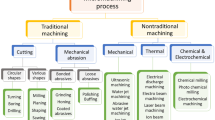Abstract
Single crystal silicon (SCS) is used in a variety of microsensor applications in which stresses and other mechanical effects may dominate device performance. One of major problems associated with the manufacturing processes of the microaccelerometer based on the tunneling current concept is temperature gradient and thermal stressess. This paper deals with finite element analyses of residual stresses causing popping up, which are induced in micromachining processes of a microaccelerometer. The authors model temperature-dependent mechanical properties during focused ion beam (FIB) cutting and Pt deposition processes. The maximum thermal strain of 0.0012 occurred at the readout gap of the microaccelerometer during the Pt deposition process. The stress produced during the heating process of FIB cut was also found to be about 33–36 MPa and cooling process the maximum equivalent stress of about 34MPa still at the right corner of readout gap. The calculated maximum displacement occurred at the readout gap was 0.14 μm. This is still smaller than the popping up of about 2 μm observed in the experiment. The reason for this popping up phenomenon in munufacturing processes of microaccelerometer may be the bending of the whole wafer or it may come from the way the underetch occurs. Different SOI material and a new geometry of the accelerometer are under investigation. We want to seek after the real cause of this pop up phenomenon and diminish this by changing munufacturing processes of microaccelerometer.
Similar content being viewed by others
References
Bryzek, J., 1996, “Impact of MEMS Technology on Society,”Sensors and Actuators, A56, pp. 1–9.
Cho, Y. H., 1993, “Micro Mechanical Engineering in Micro Electro Mechanical Systems,”Journal of the Korean Society of Mechanical Engineers, Vol. 33, No. 6, pp. 552–570.
Cho, Y. H., Kwak, B. M., Pisano A. P. and Howe R. T., 1994, “Slide Film Damping in Laterally Driven Microstructures,”Sensors and Actuators, A40, pp. 31–39.
Cho Y. H., Pisano A. P. and Howe R. T., 1994, “Viscous Damping Model for Laterally Oscillating Microstruct ures,”Journal of Microelectromechanical systems, Vol. 3 No. 2 pp. 81–87.
Crary S., Juma O. and Zhang Y., 1991, “Software Tools for Designers of Sensor and Actuator CAE Systems,”IEEE Solid-state Sensor and Actuators (Transducers 32591), San Francisco, CA, USA, pp. 498–501.
Johansson S., Ericson F. and Schweitz J., 1989, “Influence of Surface Coatings on Elasticity, Residual Stresses and Fracture Properties of Silicon Microelements,”J. Appl. Phys., Vol. 65 (1) Jan, pp. 122–128.
Kim, C. J., 1993, “Micromachining Technologies of MEMS,”Journal of the Korean Society of Mechanical Engineers, Vol. 33, No. 6, pp. 499–514.
Kim O. S., Yoshimura S. and Yagawa G., 1997, “Analyses of Joule Heat and Stresses for Microaccelerometer Based on a Tunneling Current Concept,”JSME Centennial Grand Congress, The 10th Computational Mechanics Conference, No. 97-7, O. S. 7-3, pp 59–60.
Lee K. W. and Wise K. D., 1982, “SENSIM: A Simulation Program for Solid-State Pressure Sensors,”IEEE Transactions on Electron Devices, ED-29, pp. 34–41.
Nabors K., Kim S., White J. and Senturia S., 1992, “FastCap User325s Guide,”Research Laboratory of Electronics, MIT, Cambridge, USA.
Moore D. F., Burgess S. C., Chiang H., Klaubert H., Shibaike N. and Kiriyama T., 1995, “Micromachining and Focused Ion Beam Etching of Si for Accelerometer Symposium on Micromachining and Microfabrication,”SPIE, Vol. 2639, pp. 253–258.
Pisano A. P. and Cho Y. H., 1990, “Mechanical Design Issues in Laterally-Driven Microstructures,”Sensors and Actuators, A21–A23 pp. 1060–1064
Pourahmadi F., Barth P., and Petersen K., 1990, “Modeling of Thermal and Mechanical Stresses in Silicon Microstructures,”Sensors and Actuators, A21–A23, pp. 850–858
Resnick D., Cummings K., Johnson W., Chen H., Choi B. and Engelstad R., 1994, “Temperature Uniformity Across an X-ray Mask Membrane During Baking,”Journal of Vacuum Science and Technology B 12(6), Nov/Dec.
Richard J. Young, 1993, “Micro-Machining Using a Focused Ion Beam,”Vacuum, Vol. 44, No. 3/4, pp. 353–360.
Senturia, S. D., et al, 1993, “Implementation of a MEMCAD System for Electrostatic and Mechanical Analysis of Complex Structures from Mask Description,”Proceedings of the IEEE Micro Electro Mechanical Systems Workshop, Fort Lauderadale, pp. 207–212.
Yang E. H. and Yang S. S. 1996, “The Quantitative Determination of the Residual Stress Profile in Oxidized p+ Silicon film,”Sensors and Actuators, A54, pp. 684–689.
Author information
Authors and Affiliations
Rights and permissions
About this article
Cite this article
Kim, O.S. A study on the thermal behavior in microaccelerometer manufacturing processes. KSME International Journal 12, 1126–1134 (1998). https://doi.org/10.1007/BF02942586
Received:
Issue Date:
DOI: https://doi.org/10.1007/BF02942586



